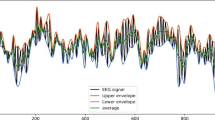Abstract
Monitors evaluating the electroencephalogram (EEG) to determine depth of anaesthesia use spectral analysis approaches for analysis windows up to 61.5 s as well as additional smoothing algorithms. Stationary EEG is required to reliably apply the index algorithms. Because of rapid physiological changes, artefacts, etc., the EEG may not always fulfil this requirement. EEG analysis using permutation entropy (PeEn) may overcome this issue, since PeEn can also be applied to practically nonstationary EEG. One objective was to determine the duration of EEG sequences that can be considered stationary at different anaesthetic levels. The second, more important objective was to test the reliability of PeEn to reflect the anaesthetic levels for short EEG segments. EEG was recorded from 15 volunteers undergoing sevoflurane and propofol anaesthesia at different anaesthetic levels and for each group 10 data sets were included. EEG stationarity was evaluated for EEG sample lengths from 4 to 116 s for each level. PeEn was calculated for these sequences using different parameter settings and analysis windows from 2 to 60 s. During wakefulness EEG can only be considered stationary for sequences up to 12 s. With increasing anaesthetic level the probability and duration of stationary EEG increases. PeEn is able to reliably separate consciousness from unconsciousness for EEG segments as short as 2 s. Especially during wakefulness a conflict between stationary EEG sequence durations and methods used for monitoring may exist. PeEn does not require stationarity and functions for EEG sequences as short as 2 s. These promising results seem to support the application of non-linear parameters, such as PeEn, to depth of anaesthesia monitoring.



Similar content being viewed by others
References
Rampil IJ. A primer for EEG signal processing in anesthesia. Anesthesiology. 1998;89:980–1002.
Viertio-Oja H, Maja V, Sarkela M, Talja P, Tenkanen N, Tolvanen-Laakso H, Paloheimo M, Vakkuri A, Yli-Hankala A, Merilainen P. Description of the entropy algorithm as applied in the datex-ohmeda S/5 entropy module. Acta Anaesth Scand. 2004;48(2):154–61.
Kawabata N. Test of statistical stability of the electroencephalogram. Biol Cybern. 1976;22(4):235–8.
Bandt C, Pompe B. Permutation entropy: a natural complexity measure for time series. Phys Rev Lett. 2002;88(17):174102.
Jordan D, Stockmanns G, Kochs EF, Pilge S, Schneider G. Electroencephalographic order pattern analysis for the separation of consciousness and unconsciousness: an analysis of approximate entropy, permutation entropy, recurrence rate, and phase coupling of order recurrence plots. Anesthesiology. 2008;109(6):1014–22.
Olofsen E, Sleigh JW, Dahan A. Permutation entropy of the electroencephalogram: a measure of anaesthetic drug effect. Br J Anaesth. 2008;101(6):810–21.
Horn B, Pilge S, Kochs EF, Stockmanns G, Hock A, Schneider G. A combination of electroencephalogram and auditory evoked potentials separates different levels of anesthesia in volunteers. Anesth Analg. 2009;108(5):1512–21.
Bendat JS, Piersol AG. Random data analysis and measurement procedures. 2nd ed. New York: Wiley; 1986.
Beck TW, Housh TJ, Weir JP, Cramer JT, Vardaxis V, Johnson GO, Coburn JW, Malek MH, Mielke M. An examination of the runs test, reverse arrangements test, and modified reverse arrangements test for assessing surface EMG signal stationarity. J Neurosci Methods. 2006;156(1–2):242–8.
Smith WD, Dutton RC, Smith NT. Measuring the performance of anesthetic depth indicators. Anesthesiology. 1996;84(1):38–51.
Jordan D, Steiner M, Kochs EF, Schneider G. A program for computing the prediction probability and the related receiver operating characteristic graph. Anesth Analg. 2010;111(6):1416–21.
Cohen BA, Sances A Jr. Stationarity of the human electroendephalogram. Med Biol Eng Comput. 1977;15(5):513–8.
John ER, Prichep LS. The anesthetic cascade: a theory of how anesthesia suppresses consciousness. Anesthesiology. 2005;102(2):447–71.
Kreuzer M, Zanner R, Pilge S, Paprotny S, Kochs EF, Schneider G. Time delay of monitors of the hypnotic component of anesthesia: analysis of state entropy and index of consciousness. Anesth Analg. 2012;115(2):315–9.
Pilge S, Zanner R, Schneider G, Blum J, Kreuzer M, Kochs E. Time delay of index calculation: analysis of cerebral state, bispectral, and narcotrend indices. Anesthesiology. 2006;104(3):488–94.
Zanner R, Pilge S, Kochs EF, Kreuzer M, Schneider G. Time delay of electroencephalogram index calculation: analysis of cerebral state, bispectral, and Narcotrend indices using perioperatively recorded electroencephalographic signals. Br J Anaesth. 2009;103(3):394–9.
Dutton RC, Smith WD, Smith NT. Brief wakeful response to command indicates wakefulness with suppression of memory formation during surgical anesthesia. J Clin Monit. 1995;11(1):41–6.
Dutton RC, Smith WD, Smith NT. Wakeful response to command indicates memory potential during emergence from general anesthesia. J Clin Monit. 1995;11(1):35–40.
Author information
Authors and Affiliations
Corresponding author
Rights and permissions
About this article
Cite this article
Kreuzer, M., Kochs, E.F., Schneider, G. et al. Non-stationarity of EEG during wakefulness and anaesthesia: advantages of EEG permutation entropy monitoring. J Clin Monit Comput 28, 573–580 (2014). https://doi.org/10.1007/s10877-014-9553-y
Received:
Accepted:
Published:
Issue Date:
DOI: https://doi.org/10.1007/s10877-014-9553-y




